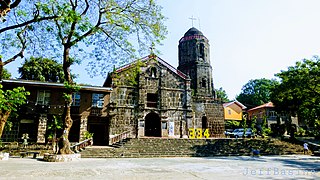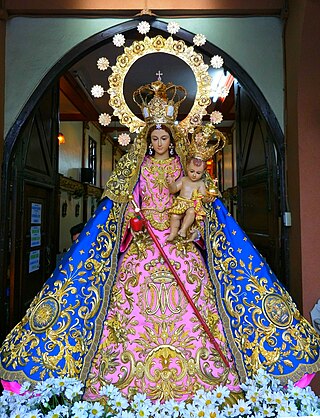
Rizal, officially the Province of Rizal, is a province in the Philippines located in the Calabarzon region in Luzon. Its capital is the city of Antipolo. It is about 16 kilometers (9.9 mi) east of Manila. The province is named after José Rizal, one of the main national heroes of the Philippines. It is bordered by Metro Manila to the west, Bulacan to the north, Quezon to the east and Laguna to the southeast. The province also lies on the northern shores of Laguna de Bay, the largest lake in the country. Rizal is a mountainous province perched on the western slopes of the southern portion of the Sierra Madre mountain range.

Antipolo, officially the City of Antipolo, is a 1st class component city and capital of the province of Rizal, Philippines. According to the 2020 census, it has a population of 887,399 people. It is the most populous city in the Calabarzon region, and the seventh most-populous city in the Philippines. It is also the most populated city under the component city status.

Teresa, officially the Municipality of Teresa, is a 2nd class municipality in the province of Rizal, Philippines. According to the 2020 census, it has a population of 64,072 people.

Tanay, officially the Municipality of Tanay, is a 1st class municipality in the province of Rizal, Philippines. According to the 2020 census, it has a population of 139,420 people.

Baras, officially the Municipality of Baras, is a 4th class municipality in the province of Rizal, Philippines. According to the 2020 census, it has a population of 87,637 people.

Morong, officially the Municipality of Morong, is a 2nd class municipality located in the province of Rizal, Philippines. As per the 2020 census, Morong has a population of 71,151 people.

Pililla, officially the Municipality of Pililla, is a 1st class municipality in the province of Rizal, Philippines. According to the 2020 census, it has a population of 71,535 people. It is surrounded by farms, small mountains, plains, and trees. Pililla is known as the Green Field Municipality of Rizal.

The Diocese of Malolos is a Latin Church ecclesiastical jurisdiction or diocese of the Catholic Church in the Philippines, encompassing the whole Province of Bulacan and Valenzuela City in metropolitan Manila and is a suffragan to the metropolitan Archdiocese of Manila. The mother church of the Diocese is the Cathedral-Basilica of the Immaculate Conception located in Malolos City, Bulacan. The Blessed Virgin Mary, under the title of Immaculate Conception is the principal patroness of the diocese.
The geography of the City of Manila is characterized by its coastal position at the estuary of the Pasig River that flows to Manila Bay. The city is located on a naturally protected harbor, regarded as one of the finest harbors in Asia. The scarce availability of land is a contributing factor that makes Manila the densest populated city in the world.

Our Lady of Peace and Good Voyage, also known as Our Lady of Antipolo and the Virgin of Antipolo, is a seventeenth-century Roman Catholic wooden image of the Blessed Virgin Mary as venerated in the Philippines. This Black Madonna is enshrined in Antipolo Cathedral in the Sierra Madre mountains east of Metro Manila.

The Diocesan Shrine and Parish of Our Lady of Light, popularly known as Cainta Church, is a Roman Catholic parish church located along Andres Bonifacio Avenue in Barangay San Andres, Cainta, Rizal, in the Philippines. The church also operates a neighboring school, Cainta Catholic College. From its time of erection as a parish in 1760 until 1983, it belonged to the Archdiocese of Manila. It was placed under the newly created Diocese of Antipolo in 1983, which is now headed by Ruperto C. Santos. It belongs to the Vicariate of Our Lady of Light.

The Diocesan Shrine and Parish of St. Joseph, also known as Baras Church, is a Roman Catholic church located in Baras, Rizal, Philippines, where the miraculous centuries-old image of San Jose de Baras is enshrined. The church is known to be the oldest parish dedicated to Saint Joseph in the Southern Tagalog Region.

Saint Jerome Parish Church, also known as Morong Church, is a Roman Catholic church located in Morong, Rizal, Philippines. It was built during the Spanish period in the country, with stones from a hill called Kay Ngaya; lime from the stones of the mountain Kay Maputi; and sand and gravel from Morong River.

The Diocesan Shrine of the Our Lady of Candelaria Parish Church, commonly known as the Silang Church, is a Roman Catholic parish church in the municipality of Silang, in the province of Cavite, Philippines under the Roman Catholic Diocese of Imus. Its titular is the Our Lady of Candelaria. The church is known for its Spanish colonial architectural style and the rococo-influenced retablos. It is the oldest existing stone church in the province of Cavite having completed in 1639.

Morong was an administrative division of the Philippines that existed as a politico-military district created out of parts of the provinces of Tondo and Laguna on February 23, 1853, by a decree of the Superior Gobierno, composing Morong, Pililla, Tanay, Baras, Binangonan, Jalajala, Angono and Cardona from Laguna; and Antipolo, Boso-Boso, Cainta and Taytay from Tondo. The offices were housed at a building now known as Comandancia. Its first military governor was Francisco Turrentigue.

La Purisima Concepcion de la Virgen Maria Parish Church, commonly known as Baclayon Church, is a Roman Catholic church in the municipality of Baclayon, Bohol, Philippines within the jurisdiction of the Diocese of Tagbilaran. Baclayon was founded by the Jesuit priest Juan de Torres and Gabriel Sánchez in 1596, and became the oldest Christian settlement in Bohol. It was elevated as a parish in 1717 and the present coral stone church was completed in 1727. The Augustinian Recollects succeeded the Jesuits in 1768 and heavily renovated the church since then.

The Diocesan Shrine and Parish of St. Mary Magdalene, also known as Pililla Church, is a Roman Catholic church located in the municipality of Pillila, Province of Rizal, Philippines. The church was built by the Franciscans in 1583, under the patronage of Saint Mary Magdalene. It is a few kilometers away from San Ildefonso Parish Church, a historical church in Tanay.

The San Pedro Apostol Parish Church, commonly known as Loboc Church and alternatively as the Diocesan Shrine of Our Lady of Guadalupe in Extremadura, is a Roman Catholic church in the municipality of Loboc, Bohol, Philippines, within the jurisdiction of the Roman Catholic Diocese of Tagbilaran.

The Our Lady of Mount Carmel Parish, commonly referred as Nuestra Señora Del Carmen Parish, is a Roman Catholic church situated in Km. 38, Barangay Pulong Buhangin, Santa Maria, in the province of Bulacan, Philippines. It is under the jurisdiction of the Roman Catholic Diocese of Malolos and within the Vicariate of Santa Maria.

Our Lady of Aránzazu and is a Roman Catholic title of the image of the Blessed Virgin Mary venerated in San Mateo, Rizal, Philippines.































